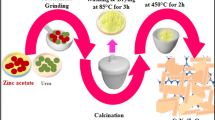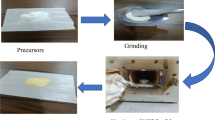Abstract
Photoelectrocatalytic (PEC) oxidation is a promising method in water treatment due to the synergistic effect of photocatalytic (PC) oxidation and electro-oxidation. Up to now, developing visible-light-responsive, efficient and environmental-friendly electrode for PEC degradation application is still a challenge. In this work, novel and environmental-friendly TiO2/C3N4 core–shell nanowire arrays as an electrode were investigated for PEC degradation of bisphenol A (BPA). TiO2 nanowire arrays provide a direct electron pathway, g-C3N4 serves as a stable and environmental-friendly visible light sensitizer, and effective charge spatial separation can be achieved across the well-matched core–shell interface. Compared with TiO2 nanowire arrays, TiO2/C3N4 core–shell nanowire arrays exhibit higher PC and PEC performance. The photocurrent response of the TiO2 nanowire arrays is enhanced about two times after C3N4 shell deposition. And the PEC performance of TiO2/C3N4 core–shell nanowire arrays is significantly enhanced, which is one time higher than that of TiO2 (under 1.0 V external potential). The enhancement of PEC performance of TiO2 nanowire arrays after C3N4 modification can be attributed to the synergistic photoelectric effect, well-matched interface and efficient charge separation induced by the type-II TiO2/C3N4 band alignment. Moreover, the intermediate products of BPA degradation by PEC oxidation were analyzed by gas chromatography–mass spectrometry and five specific products were identified, and then two possible pathways for BPA degradation by PEC process were proposed.








Similar content being viewed by others
References
Mills A, Hunte SL (1997) An overview of semiconductor photocatalysis. J Photochem Photobiol A 108:1–35
Hernández Alonso MD, Fresno SSF, Coronado JM (2009) Development of alternative photocatalysts to TiO2: challenges and opportunities. Energy Environ Sci 2:1231–1257
Xiao P, Lou J, Zhang H et al (2018) Enhanced visible-light-driven photocatalysis from WS2 quantum dots coupled to BiOCl nanosheets: synergistic effect and mechanism insight. Catal Sci Technol 8:201–209
Chang S, Wang Q, Liu B, Sang Y, Liu H (2017) Hierarchical TiO2 nanonetwork-porous Ti 3D hybrid photocatalysts for continuous-flow photoelectrodegradation of organic pollutants. Catal Sci Technol 7:524–532
Li XZ, Liu HS (2005) Development of an E-H2O2/TiO2 photoelectrocatalytic oxidation system for water and wastewater treatment. Environ Sci Technol 39:4614–4620
Quan X, Yang S, Ruan X, Zhao H (2005) Preparation of titania nanotubes and their environmental applications as electrode. Environ Sci Technol 39:3770–3775
Wang Y, Zhan X, Wang F, Wang Q et al (2014) Crystalline ZnO/ZnS x Se1−x core-shell nanowire arrays for efficient visible-light photoelectrocatalysis. J Mater Chem A 2:18413–18419
Zanoni MVB, Sene JJ, Anderson MA (2003) Photoelectrocatalytic degradation of Remazol Brilliant Orange 3R on titanium dioxide thin-film electrodes. J Photochem Photobiol A 157:55–63
Wang Y, Shi R, Lin J, Zhu Y (2010) Significant photocatalytic enhancement in methylene blue degradation of TiO2 photocatalysts via graphene-like carbon in situ hybridization. Appl Catal B Environ 100:179–183
Konstantinou IK, Albanis TA (2004) TiO2-assisted photocatalytic degradation of azo dyes in aqueous solution: kinetic and mechanistic investigations: a review. Appl Catal B Environ 49:1–14
Tachikawa T, Fujitsuka M, Majima T (2007) Mechanistic insight into the TiO2 photocatalytic reactions: design of new photocatalysts. J Phys Chem C 111:5259–5275
Li H, Cheng C, Li X, Liu J, Guan C, Tay YY et al (2011) Composition-graded Zn x Cd1−xSe@ZnO core-shell nanowire array electrodes for photoelectrochemical hydrogen generation. J Phys Chem C 116:3802–3807
Wang Y, Wang F, He J (2013) Controlled fabrication and photocatalytic properties of a three-dimensional ZnO nanowire/reduced graphene oxide/CdS heterostructure on carbon cloth. Nanoscale 5:11291–11297
Cao X, Tian G, Chen Y, Zhou J, Zhou W, Tian C et al (2014) Hierarchical composites of TiO2 nanowire arrays on reduced graphene oxide nanosheets with enhanced photocatalytic hydrogen evolution performance. J Mater Chem A 2:4366–4374
Wang C, Chen Z, Jin H, Cao C, Li J, Mi Z (2014) Enhancing visible-light photoelectrochemical water splitting through transition-metal doped TiO2 nanorod arrays. J Mater Chem A 2:17820–17827
Hoang S, Berglund SP, Hahn NT, Bard AJ, Mullins CB (2012) Enhancing visible light photo-oxidation of water with TiO2 nanowire arrays via cotreatment with H2 and NH3: synergistic effects between Ti3+ and N. J Am Chem Soc 134:3659–3662
Pu YC, Wang G, Chang KD, Ling Y, Lin YK, Fitzmorris BC et al (2013) Au nanostructure-decorated TiO2 nanowires exhibiting photoactivity across entire UV-visible region for photoelectrochemical water splitting. Nano Lett 13:3817–3823
Teng W, Li X, Zhao Q, Chen G (2013) Fabrication of Ag/Ag3PO4/TiO2 heterostructure photoelectrodes for efficient decomposition of 2-chlorophenol under visible light irradiation. J Mater Chem A 1:9060–9068
Liu S, Li H, Mo R, Chen Q, Yang S, Zhong J (2016) ZnSe sensitized and Co-Pi catalyzed TiO2 nanowire array photoanode for solar-driven water splitting. J Electrochem Soc 163:H744–H749
Ai G, Sun W, Gao X, Zhang Y, Peng LM (2011) Hybrid CdSe/TiO2 nanowire photoelectrodes: fabrication and photoelectric performance. J Mater Chem 21:8749–8755
Ai G, Li H, Liu S, Mo R, Zhong J (2015) Solar water splitting by TiO2/CdS/Co-Pi nanowire array photoanode enhanced with Co–Pi as hole transfer relay and CdS as light absorber. Adv Funct Mater 25:5706–5713
Yang H, Fan W, Vaneski A, Susha AS, Teoh WY, Rogach AL (2012) Heterojunction engineering of CdTe and CdSe quantum dots on TiO2 nanotube arrays: intricate effects of size-dependency and interfacial contact on photoconversion efficiencies. Adv Funct Mater 22:2821–2829
Ge M, Cao C, Huang J, Li S, Chen Z, Zhang KQ et al (2016) A review of one-dimensional TiO2 nanostructured materials for environmental and energy applications. J Mater Chem A 4:6772–6801
Mahadik MA, Shinde PS, Cho M, Jang JS (2015) Fabrication of a ternary CdS/ZnIn2S4/TiO2 heterojunction for enhancing photoelectrochemical performance: effect of cascading electron–hole transfer. J Mater Chem A 3:23597–23606
Wang X, Maeda K, Thomas A, Takanabe K, Xin G, Carlsson JM et al (2009) A metal-free polymeric photocatalyst for hydrogen production from water under visible light. Nat Mater 8:76–80
Wang X, Maeda K, Chen X, Takanabe K, Domen K, Hou Y et al (2009) Polymer semiconductors for artificial photosynthesis: hydrogen evolution by mesoporous graphitic carbon nitride with visible light. J Am Chem Soc 131:1680–1681
Ong WJ, Tan LL, Ng YH, Yong ST, Chai SP (2016) Graphitic carbon nitride (g-C3N4)-based photocatalysts for artificial photosynthesis and environmental remediation: are we a step closer to achieving sustainability. Chem Rev 116:7159–7329
Wang Y, Wang X, Antonietti M (2012) Polymeric graphitic carbon nitride as a heterogeneous organocatalyst: from photochemistry to multipurpose catalysis to sustainable chemistry. Angew Chem Int Edit 51:68–89
Wang Y, Shi R, Lin J, Zhu Y (2011) Enhancement of photocurrent and photocatalytic activity of ZnO hybridized with graphite-like C3N4. Energy Environ Sci 4:2922–2929
Wang Y, Bai X, Pan C, He J, Zhu Y (2012) Enhancement of photocatalytic activity of Bi2WO6 hybridized with graphite-like C3N4. J Mater Chem 22:11568–11573
Wang Y, Wang Z, Muhammad S, He J (2012) Graphite-like C3N4 hybridized ZnWO4 nanorods: synthesis and its enhanced photocatalysis in visible light. Cryst Eng Comm 14:5065–5070
Hao R, Wang G, Tang H, Sun L, Xu C, Han D (2016) Template-free preparation of macro/mesoporous g-C3N4/TiO2 heterojunction photocatalysts with enhanced visible light photocatalytic activity. Appl Catal B-Environ 187:47–58
Chen X, Wei J, Hou R, Liang Y, Xie Z, Zhu Y et al (2016) Graphene-based photocatalytic composites. Appl Catal B Environ 188:342–350
Zhou J, Zhang M, Zhu Y (2015) Photocatalytic enhancement of hybrid C3N4/TiO2 prepared via ball milling method. Phys Chem Chem Phys 17:3647–3652
Gu L, Wang J, Zou Z, Han X (2014) Graphitic-C3N4-hybridized TiO2 nanosheets with reactive 001 facets to enhance the UV-and visible-light photocatalytic activity. J Hazard Mater 268:216–223
Yang L, Li Z, Jiang H, Jiang W, Su R, Luo S et al (2016) Photoelectrocatalytic oxidation of bisphenol A over mesh of TiO2/graphene/Cu2O. Appl Catal B-Environ 183:75–85
Xiang G, Yu Z, Hou Y, Chen Y, Peng Z, Sun L et al (2016) Simulated solar-light induced photoelectrocatalytic degradation of bisphenol-A using Fe3+-doped TiO2 nanotube arrays as a photoanode with simultaneous aeration. Sep Purif Technol 161:144–151
Feng X, Shankar K, Varghese K, Paulose M, Latempa J, Grimes A (2008) Vertically aligned single crystal TiO2 nanowire arrays grown directly on transparent conducting oxide coated glass: synthesis details and applications. Nano Lett 8:3781–3786
Cao S, Low J, Yu J, Jaroniec M (2015) Polymeric photocatalysts based on graphitic carbon nitride. Adv Mater 27:2150–2176
Zheng Y, Lin L, Wang B, Wang X (2015) Graphitic carbon nitride polymers toward sustainable photoredox catalysis. Angew Chem Int Edit 54:12868–12884
Wang XJ, Yang WY, Li FT, Xue YB, Liu RH, Hao YJ (2013) In situ microwave-assisted synthesis of porous N-TiO2/g-C3N4 heterojunctions with enhanced visible-light photocatalytic properties. Ind Eng Chem Res 52:17140–17150
Yan SC, Li ZS, Zou ZG (2010) Photodegradation of rhodamine B and methyl orange over boron-doped g-C3N4 under visible light irradiation. Langmuir 26:3894–3901
Ng J, Wang X, Sun D (2011) One-pot hydrothermal synthesis of a hierarchical nanofungus-like anatase TiO2 thin film for photocatalytic oxidation of bisphenol A. Appl Catal B Environ 110:260–272
Ng J, Xu S, Zhang X, Yang H, Sun D (2010) Hybridized nanowires and cubes: a novel architecture of a heterojunctioned TiO2/SrTiO3 thin film for efficient water splitting. Adv Funct Mater 20:4287–4294
Leng WH, Zhang Z, Zhang JQ, Cao CN (2005) Investigation of the kinetics of a TiO2 photoelectrocatalytic reaction involving charge transfer and recombination through surface states by electrochemical impedance spectroscopy. J Phys Chem B 109:15008–15023
Wang Y, Xu J, Zong W, Zhu Y (2011) Enhancement of photoelectric catalytic activity of TiO2 film via polyaniline hybridization. J Solid State Chem 184:1433–1438
Zhao X, Xu T, Yao W, Zhang C, Zhu Y (2007) Photoelectrocatalytic degradation of 4-chlorophenol at Bi2WO6 nanoflake film electrode under visible light irradiation. Appl Catal B-Environ 72:92–97
Zhang T, Ding Y, Tang H (2015) Generation of singlet oxygen over Bi(V)/Bi(III) composite and its use for oxidative degradation of organic pollutants. Chem Eng J 264:681–689
Han Q, Wang H, Dong W, Liu T, Yin Y, Fan H (2015) Degradation of bisphenol A by ferrate (VI) oxidation: kinetics, products and toxicity assessment. Chem Eng J 262:34–40
Wang C, Zhu L, Wei M, Chen P, Shan G (2012) Photolytic reaction mechanism and impacts of coexisting substances on photodegradation of bisphenol A by Bi2WO6 in water. Water Res 46:845–853
Lee H, Choi W (2002) Photocatalytic oxidation of arsenite in TiO2 suspension: kinetics and mechanisms. Environ Sci Technol 36:3872–3878
Wang Y, Wang Q, Zhan X, Wang F, Safdar M, He J (2013) Visible light driven type II heterostructures and their enhanced photocatalysis properties: a review. Nanoscale 5:8326–8339
Acknowledgements
This work is supported by the National Science Foundation of China (Grant Nos. 91645108, U1162117, 21307020), Beijing Nova Program (Grant No. Z161100004916121), Prospect Oriented Foundation of China University of Petroleum, Beijing (Grant No. QZDX-2014-02), Beijing Higher Education Young Elite Teacher Project (YETP0696), Beijing Natural Science Foundation (Grant No. 2144059) and Science Foundation of China University of Petroleum, Beijing (Grant Nos. 2462014YJRC010, C201604).
Author information
Authors and Affiliations
Corresponding author
Ethics declarations
Conflict of interest
The authors declare that there is no conflict of interest regarding the publication of this paper.
Electronic supplementary material
Below is the link to the electronic supplementary material.
Rights and permissions
About this article
Cite this article
Wang, Y., Wu, Q., Li, Y. et al. Controlled fabrication of TiO2/C3N4 core–shell nanowire arrays: a visible-light-responsive and environmental-friendly electrode for photoelectrocatalytic degradation of bisphenol A. J Mater Sci 53, 11015–11026 (2018). https://doi.org/10.1007/s10853-018-2368-3
Received:
Accepted:
Published:
Issue Date:
DOI: https://doi.org/10.1007/s10853-018-2368-3




